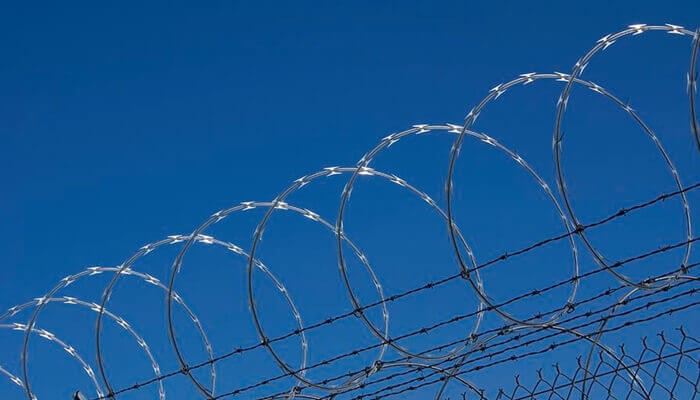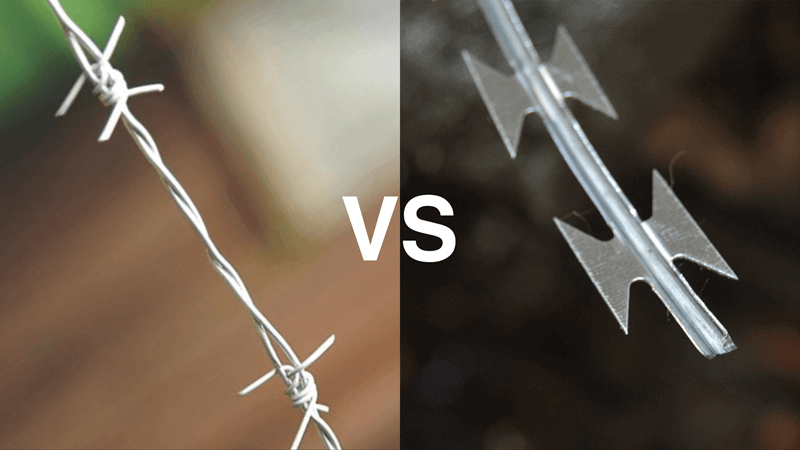What is Razor Wire? A Complete Guide to High-Security Perimeter Fencing
- Updated: November 18, 2025
- Post Views: 7
- By: Shengsen Metal
Razor wire is a high-security fencing solution made of sharp-edged steel tape wrapped around a strong wire core. It’s designed to physically stop intruders and psychologically deter attempts—making it ideal for prisons, borders, military zones, and critical infrastructure.
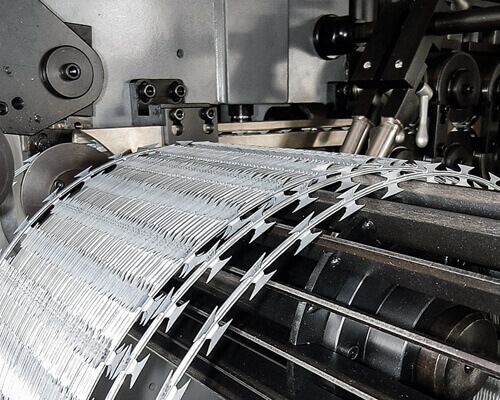
Introduction
Let’s talk about perimeter security. If you’re managing a facility with valuable assets or restricted areas, you know that a basic fence is sometimes just… not enough. You need something that actually makes people think twice.
That’s where razor wire comes in.
You’ve probably seen it—wrapped around prison fences, stretched across military bases, or topping the walls of high-security facilities. It’s not there to look pretty. It’s there because it works. It’s one of the most effective physical barriers you can install, and when you need real security, it’s hard to beat.

In this guide, we’re walking through everything you need to know about razor wire. What it is, how it’s made, where it works best, and how to choose the right type for your situation. Whether you’re securing a warehouse, a border checkpoint, or critical infrastructure, understanding razor wire will help you make smarter decisions about your perimeter protection.
Let’s dive in.
What is Razor Wire? Understanding the Basics
More Than Just Sharp Metal
Razor wire—sometimes called razor tape or barbed tape—is a high-security fencing material made of sharp steel blades wrapped around a wire core. Unlike old-school barbed wire with its twisted points every few inches, razor wire gives you continuous sharp edges that make climbing or cutting through it a serious challenge.
Think of it as barbed wire’s much tougher cousin.
How Razor Wire is Constructed
Razor wire has two main parts working together:
Steel Core: The Structural Foundation
At the center, you’ve got a high-tensile steel wire (usually about 2.5mm thick) that gives the whole thing its strength.
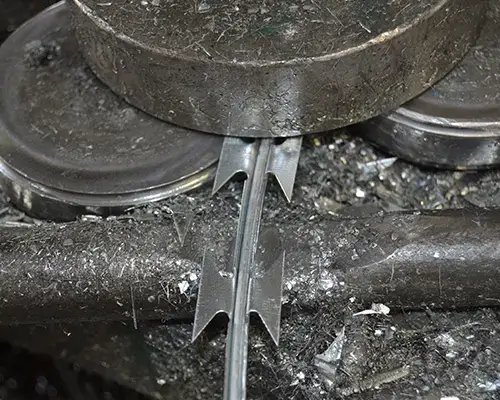
Most use galvanized steel to fight off rust, though if you’re near the ocean or in a harsh environment, stainless steel is the way to go. This core keeps everything tight and in shape, even when it’s stretched during installation.
Razor Blade Strip: The Cutting Edge
Here’s where it gets serious. A flat steel strip—about 0.5-0.6mm thick—is precision-punched with sharp blade patterns, then wrapped and crimped onto that core wire in a continuous spiral.
The blade spacing, angle, and sharpness all work together to make this barrier genuinely difficult to deal with. You can’t just grab it and pull yourself over.
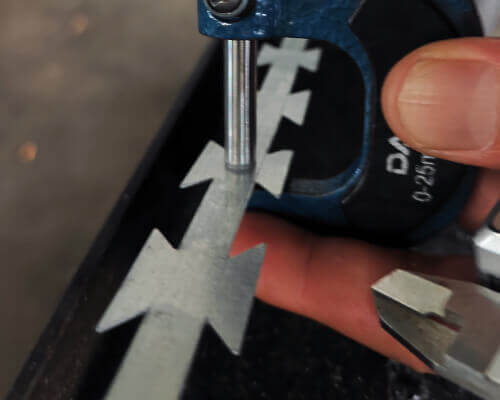
Material Options: Choosing the Right Steel
Galvanized Steel
This is your standard option. Hot-dip galvanized steel gives you 10-15 years of solid performance in most conditions, and it won’t break the bank. Perfect for industrial sites, commercial properties, or anywhere you need good protection without going overboard on cost.
Stainless Steel
If you’re in a coastal area, dealing with chemicals, or just want something that’ll last forever, stainless steel (usually 304 or 316 grade) is worth the investment. Yes, it costs 2-3 times more than galvanized, but you’re looking at 20-30+ years with almost zero maintenance. Military installations and critical infrastructure often go this route.
PVC-Coated Options
Need it to blend in? PVC coating comes in green, black, or custom colors. The coating adds protection and helps with aesthetics, though it does slightly dull the blade edges. Either way, anyone installing it still needs serious protective gear—the blades underneath don’t care about the pretty color.

Razor Wire vs. Barbed Wire: Key Differences
Traditional barbed wire is basically two twisted strands with sharp points spaced out. It’s fine for keeping cattle in and maybe slowing down a trespasser, but it’s more of a “please don’t” than a “you absolutely cannot.”
Razor wire is a different game entirely. Those continuous blades create way more contact points, they resist cutting tools better, and the design makes it nearly impossible to compress or manipulate safely. Where barbed wire might delay someone by a few seconds, razor wire often stops them completely.
Of course, that means you need to be more careful about where and how you use it. Proper warning signs aren’t just nice to have—they’re usually required. And you need to think about installation height to avoid liability issues. With more stopping power comes more responsibility.
Types of Razor Wire: Finding the Right Configuration
Not all razor wire looks the same, and that’s by design. Different situations call for different configurations. Let’s walk through what’s out there.
| Type | Best For | Security Level |
| Concertina Coils | Military, prisons, borders | High |
| Spiral Razor Wire | Fence tops, temporary barriers | Medium |
| Flat Wrap | Urban sites, tight spaces | Medium–High |
| Welded Razor Mesh | Maximum security facilities | Maximum |
Concertina Coils: Maximum Security, Quick Deployment
What It Looks Like
Picture a spring made of razor wire, with the loops clipped together at regular spots. When you stretch it out, those clips keep everything aligned in a tight, overlapping pattern that’s incredibly hard to get through. Coils usually come in 450mm to 980mm diameters.

Best Used For
Military folks love concertina wire because you can roll it out fast—a small team can set up hundreds of meters in under an hour. Prisons use it to create serious barriers between security zones. Border operations rely on it where permanent fencing isn’t practical.
The connected design means even if someone tries to compress it or spread it apart, those clips hold firm. A 450mm coil stretches about 7-8 meters, while a 980mm one can cover 12-15 meters.
Safety Note
Handling concertina during setup is genuinely dangerous. Your installers need thick gloves, arm guards, eye protection, the works. This isn’t a DIY weekend project unless you really know what you’re doing.
Spiral Razor Wire: Flexible but Less Secure
What It Looks Like
Spiral wire looks similar to concertina, but without those connecting clips. That makes it more flexible—you can stretch it further or shape it to fit irregular fence lines.

The Security Trade-Off
More flexibility means less structural integrity. Without clips, the coils can be pushed apart or displaced more easily. It’ll still hurt anyone trying to mess with it, but it’s not quite as formidable as concertina. Think of it as good deterrence for opportunistic intruders, but maybe not your first choice for high-risk facilities.
Best Used For
Fence-top installations are perfect for spiral wire—you attach it directly to your chain-link or mesh fencing top rail. Temporary events, agricultural properties, and industrial yards often choose this for a cost-effective security boost without going full military-grade.
Flat Wrap Razor Wire: Low Profile, Urban-Friendly
What It Looks Like
Take a concertina coil and compress it flat against a wall or fence panel. The loops flatten out but keep their blade coverage. Usually sits 300-500mm wide and only 50-100mm off the mounting surface.

Why Choose This Type
Sometimes you need protection without the aggressive look of big coils hanging out. Urban facilities like data centers, telecom sites, or commercial properties use flat wrap to stay secure without screaming “fortress.” It’s also useful where building codes restrict how far barriers can overhang your property line.
Effectiveness vs. Appearance
Even though it looks less intimidating, flat wrap is still effective. The compressed profile also means less risk of maintenance workers or emergency responders accidentally contacting it. But you still need proper warning signs—just because it’s lower profile doesn’t mean it’s safe to touch.
Welded Razor Mesh Panels: The Ultimate Barrier
What It Looks Like
This is top-tier security. Instead of coils, you get rigid panels where razor tape is welded into a grid pattern. Imagine a fence panel made entirely of razor wire. Panels typically come in 2m x 3m sections with 50-100mm spacing between the grid lines.
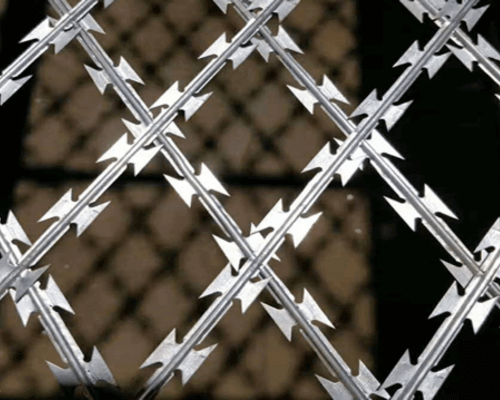
Best Used For
Maximum security prisons, nuclear facilities, military ammunition depots, sensitive government buildings—anywhere security failure is simply not an option. The welded construction means there’s no flex, no manipulation, no weak points.
Cost vs. Performance
These panels cost 3-4 times more than concertina wire, and installation requires beefier support posts to handle the rigid panel weight. But if you’re protecting something that absolutely cannot be compromised, welded mesh delivers. Plus, maintenance is basically zero—it doesn’t sag, doesn’t need adjustment, just sits there being impenetrable.
5 Common Applications of Razor Wire
Let’s talk about where razor wire actually gets used and why it makes sense in each scenario.
Military Bases and Border Security
Military bases need barriers they can deploy fast and trust completely. You can’t wait around building concrete walls when you’re setting up a forward operating base. Concertina wire solves that—roll it out, stake it down, done. No power needed, no monitoring required, just a physical barrier that works 24/7.

At borders, especially in high-traffic areas, razor wire backs up primary fencing or creates temporary channeling points during operations. It forces people toward monitored checkpoints instead of trying to cross wherever they want.
One thing worth noting—if you’re deploying near civilian areas or migration routes, you need to think through the humanitarian considerations. International agreements and public perception matter, especially at border crossings.
Correctional Facilities
Prisons and razor wire go hand in hand for good reason. You’ll see it on perimeter fence tops, between double fences, sometimes even in trenches to stop tunnel attempts. The goal is to stop escape attempts before they start—every second counts when someone tries to get out.

But here’s something people don’t always think about: it works both ways. Razor wire doesn’t just keep inmates in; it also keeps unauthorized people from getting too close. That matters when you’re trying to prevent contraband smuggling or outside threats.
Of course, you need to plan for emergencies. Staff need clear safe access points for evacuations or medical responses. The security is important, but so is being able to move quickly when things go wrong.
Critical Infrastructure
Power plants, water treatment facilities, telecom hubs—these places don’t usually make headlines until something goes wrong. And when they do, it’s a big problem for a lot of people.
That’s why you’ll see razor wire protecting these sites. Even if someone gets past detection systems, the physical barrier buys time for security to respond before any real damage happens. Often you’ll see it combined with cameras, lighting, and intrusion detection as part of a layered security approach.
Many industries have regulatory requirements for physical barriers too. Electric utilities, chemical facilities, transportation infrastructure—they all have standards to meet. Razor wire helps check those compliance boxes while actually providing meaningful protection.
Industrial and Commercial Sites
Logistics yards, construction sites, scrap metal facilities, warehouses full of inventory—these places face constant theft pressure. Cameras might catch someone on video, but razor wire on top of your fence actually stops them long enough for security or police to show up.
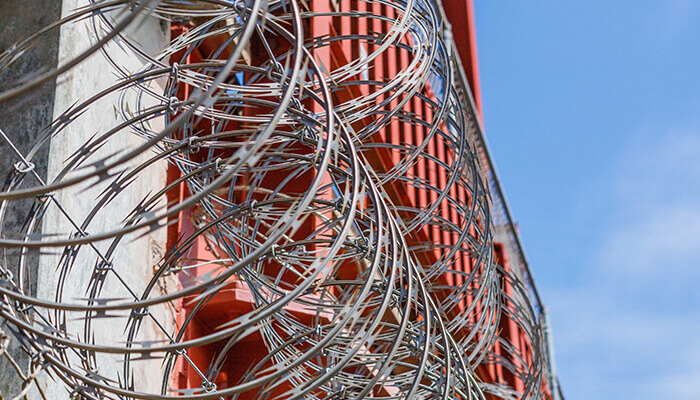
Here’s a bonus: some insurance companies offer premium discounts for enhanced physical security. The reduction in theft claims can actually offset your installation costs over time. Worth checking with your carrier.
Just remember—you need to protect your legitimate users too. Loading docks, maintenance access, emergency exits—keep those clear. Put up good warning signs (probably required by law anyway), and make sure your team knows where the razor wire is so nobody gets hurt during normal operations.
High-Security Residential Properties
In some regions—areas with high crime or political instability—you’ll see residential compounds and diplomatic facilities using razor wire on perimeter walls. Usually flat wrap to keep things less visually aggressive.
But check your local codes first. Many residential zones restrict or outright prohibit razor wire. HOAs often have rules against it too. And honestly, think about your neighbors and property values before committing to this kind of security upgrade.
Why Choose Razor Wire: Key Benefits and Limitations
So why do people keep choosing razor wire when there are so many security options out there? Let’s break down what makes it work.
Works 24/7 Without Power or Monitoring
Unlike cameras or alarms, razor wire doesn’t need electricity, internet, or someone watching a monitor. Once it’s installed, it does its job continuously. No batteries to replace, no software to update, no subscription fees.
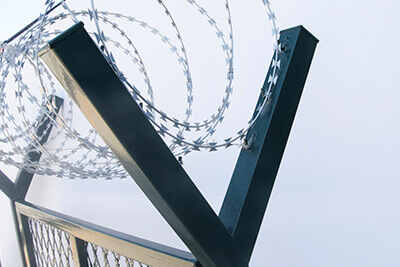
That independence is huge in remote locations, during power outages, or in disaster scenarios when other systems go down. It’s just there, doing its thing, making life difficult for anyone trying to get through.
Strong Visual Deterrent Effect
Beyond the physical barrier, razor wire sends a clear message: “This place is seriously protected.” A lot of potential intruders will simply look for easier targets. Prevention is always better than detection and response.
Of course, that aggressive appearance isn’t always appropriate. You need to balance security needs with how you want your facility to be perceived by the community.
Low Cost Over the Long Term
Galvanized concertina wire materials run about $20-35 per meter, with installation adding another $15-40 depending on complexity. Stainless steel costs more upfront ($60-100 per meter) but can last 30 years.
Compare that to electronic systems with monthly monitoring fees, regular maintenance contracts, and component replacements every few years. Over a 10-15 year span, razor wire’s total cost of ownership looks pretty good—especially since maintenance is just annual inspections and occasional coil replacement.
Enhances Existing Fencing
Most razor wire installations don’t replace your existing fence—they enhance it. You’ve already got chain-link or mesh fencing? Great. Add razor wire on top and suddenly that climbable fence becomes a serious obstacle. You keep your original investment while dramatically upgrading security.
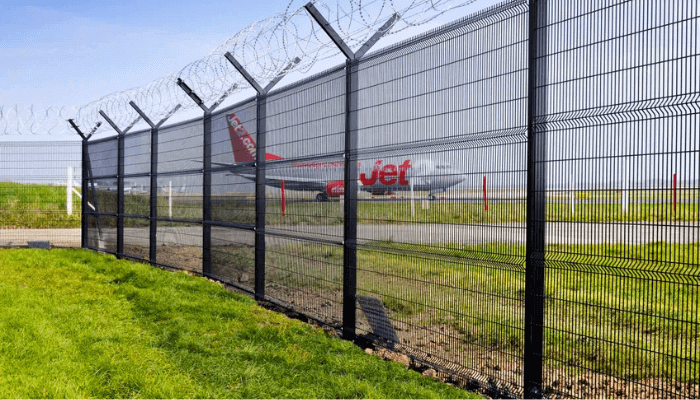
Standard brackets fit most fence types, making retrofits straightforward. Y-arm extensions create outward-angled barriers that are particularly tough to defeat (just verify you’re not overhanging your property line).
Scales to Your Security Needs
You can scale razor wire to match your actual risk. Low to moderate threat? Single-row fence-top spiral wire. High risk? Multi-row concertina barriers or welded mesh in critical sections. Your security investment matches your actual vulnerability.
And if your needs change—like a construction site becoming a permanent facility—you can often redeploy or upgrade your razor wire rather than starting from scratch.
Understanding the Limitations
Let’s be honest—razor wire isn’t perfect. Determined attackers with time and tools can eventually breach it. It works best as one layer in a comprehensive security design that includes detection, lighting, response capability, and other barriers.
You’re also taking on responsibility. Warning signs are required (and often legally mandated). Damaged sections need prompt repair. Emergency responders might need to breach your perimeter during incidents, so plan ahead and communicate with local fire and police about your layout.
And that aggressive look? It might create negative perceptions depending on your facility type. Weigh security benefits against potential impacts on community relations or public perception.
How to Select And Install Razor Wire?
Alright, you’ve decided razor wire makes sense for your situation. Now let’s talk about choosing the right specs and getting it installed properly.
Step 1: Assess Your Security Needs
Start with a real threat assessment. Are you worried about casual trespassers, organized theft, or something more serious? That determines what kind of barrier you need. Opportunistic intruders are deterred by fence-top spiral wire. Organized threats might require concertina or welded mesh.
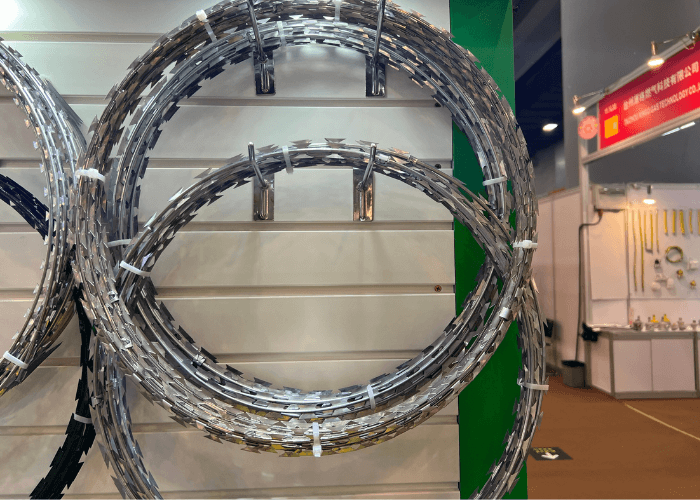
Look at your site too. Long rural perimeter? Maybe multi-row ground concertina. Urban property with existing walls? Flat wrap might be perfect. Adjacent to public spaces? You’ll face stricter height and setback requirements.
Environment matters for material choice. Coastal locations, chemical facilities, extreme temperatures—these all point toward stainless steel or enhanced corrosion protection. Heavy snow areas need consideration of how accumulated weight affects coiled barriers.
Step 2: Choose Your Materials and Specifications
Core Wire and Blade Types
Standard 2.5mm core wire works for most situations. Heavy-duty 3.0mm is available for maximum security but costs 20-30% more.
For blade profiles, BTO-22 (22mm blade length) is your workhorse—balanced performance at the best price. CBT-65 (65mm blade) is for when you need maximum deterrent effect and don’t mind the higher cost. Shorter BTO-10 or BTO-15 options exist where regulations limit blade length.

Coil Sizes and Coverage
- 450mm diameter: Fence-top mounting, covers 7-8m when stretched
- 700mm diameter: Ground barriers, 10-12m coverage
- 960mm diameter: Multi-row systems, 12-15m coverage
Larger coils cost more per unit but cover more distance—often better value for long perimeters.
Surface Coatings
Hot-dip galvanized is standard and works great for most situations. PVC coating in various colors costs 15-25% more but helps with aesthetics. Green blends with landscaping, black reduces visibility.
Step 3: Understand Installation Methods
Fence-Top Mounting
Use bracket systems to secure razor wire to your existing fence rail. Y-arm brackets create 45-degree outward angles that make scaling even harder (just make sure you’re not overhanging your property line).
Secure the wire every 1-1.5 meters with tie wire or hog rings. Closer spacing prevents sagging and keeps everything tight.
Ground Deployment
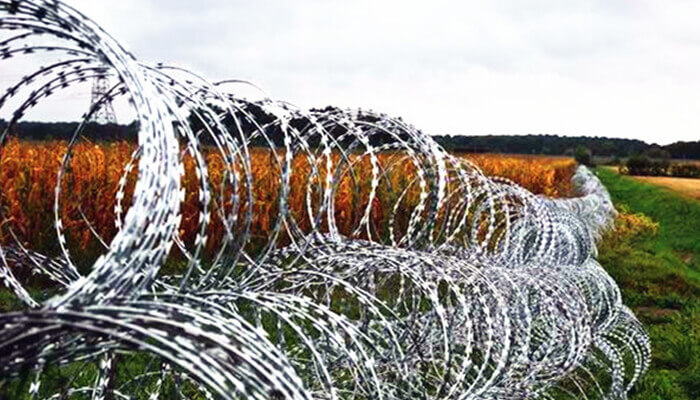
Single-row concertina provides basic deterrence but can be jumped or cut through. Three-row pyramid configurations (two bottom, one on top) create a real obstacle. Five-row setups (three bottom, two top) are for maximum security.
Stake coils every 3-5 meters to prevent wind or tampering from moving them. Temporary installations can use sandbags or barriers instead of ground stakes.
Critical Safety Requirements
This is serious: installers need heavy cut-resistant gloves, long sleeves, full-length pants, safety glasses, and steel-toed boots. Even with proper gear, small cuts happen. Larger injuries need immediate medical attention.
Never let coils spring open uncontrolled—compressed razor wire releasing suddenly can cause severe injuries. Work systematically with one person handling the coil and another managing tension and mounting.
Step 4: Gather Required Accessories
Installation Hardware
- Mounting brackets (type depends on your setup)
- Tie wire or hog rings (stainless in corrosive environments)
- Ground stakes or anchors
- Tension bands for connecting adjacent coils
Safety and Compliance Items
- Warning signs (often legally required—check local codes)
- Installation PPE
- Touch-up paint for fixing any galvanization damage
- Documentation logs for inspections and maintenance
Step 5: Verify Legal Compliance
Many jurisdictions regulate razor wire through zoning or building codes. Common restrictions include minimum heights (often 2 meters), prohibition near schools or residential areas, setback requirements from property lines, and mandatory warning signage.
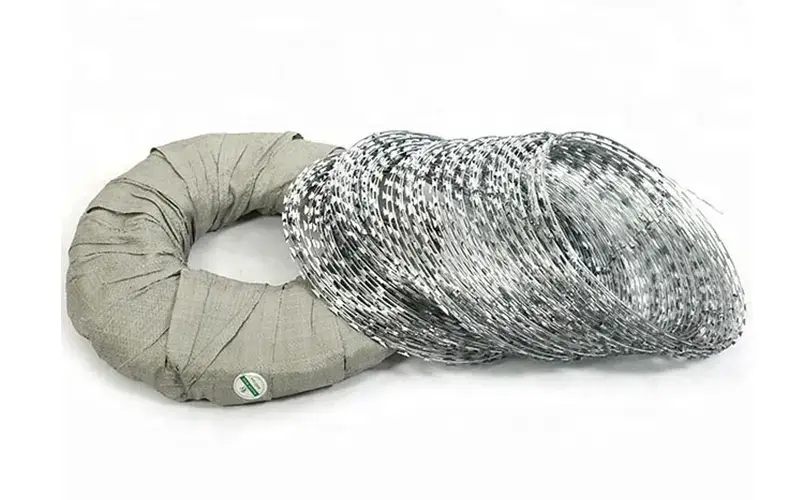
Check with your local building department before you buy anything. Some places require permits even for fence modifications. Better to know now than get a removal order later.
Also, notify your insurance carrier. Razor wire might affect liability coverage or premiums—some policies require it for high-value properties, others might have exclusions.
And coordinate with local emergency responders. Give them site maps showing razor wire locations and emergency access points. Some facilities keep bolt cutters accessible for emergency breaches.
Budget Planning: What to Expect
Material Costs (Approximate)
- Galvanized concertina (450mm, BTO-22): $20-35 per coil
- Stainless concertina (450mm, BTO-22): $60-100 per coil
- Welded mesh panels: $150-300 per square meter
- Hardware and brackets: $3-8 per meter of fence
For your project and wholesale business, you can always get factory direct prices from your razor wire suppliers.
Installation Labor
Professional installation: $15-40 per meter depending on complexity and location. DIY is possible with proper safety equipment and training, but professional installation ensures it’s done right and safely.
Long-Term Maintenance
Annual inspection and minor repairs: $500-2,000 for medium facilities. Major damage requires coil replacement based on affected length. Even the best materials need replacement after 10-30 years depending on the environment.
Frequently Asked Questions
Is razor wire legal where I am?
It varies a lot. Industrial zones usually allow it with few restrictions. Residential areas often prohibit it or require permits and minimum heights.
Always check local zoning codes and building regulations before purchasing. You don’t want to install something you’ll be forced to remove.
What makes razor wire different from barbed wire?
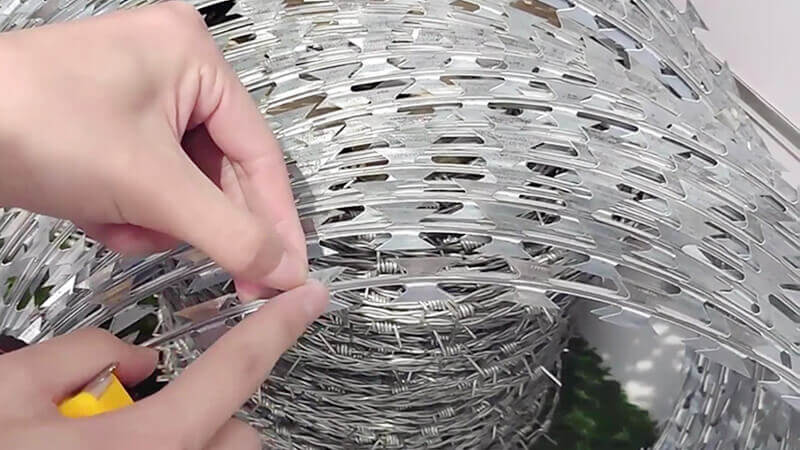
Barbed wire has twisted strands with points every few inches—it’s more of a deterrent than a real barrier.
Razor wire has continuous sharp blade edges that actually stop climbing and cutting attempts. It’s way more effective but also more dangerous to install and handle.
How long will it last?
Galvanized steel: 10-15 years in normal conditions, maybe 7-10 in harsh environments. Stainless steel: 20-30+ years even in coastal or chemical exposure. Regular inspections and fixing damage when you spot it helps either type last longer.
Can I install this myself?
Technically yes, but think hard about it. You need serious safety gear—cut-resistant gloves, arm protection, eye guards, heavy clothing. Even with proper equipment, this stuff is dangerous.
Most people are better off hiring pros who know proper technique and have the right tools. Installation mistakes can reduce effectiveness and create liability issues.
What maintenance does it need?
Not much, but it’s important. Check annually for rust spots, loose hardware, damage from weather or tampering, and faded warning signs.
Fix issues promptly to keep the barrier working and reduce your liability exposure.
Will this hurt animals?
Yes, it can. Razor wire isn’t appropriate for livestock fencing or anywhere pets might reach it. Wild animals can also be injured crossing barriers.
If wildlife is a concern, design your fence so animals can’t reach the razor wire sections—maybe use solid lower panels with razor wire only at heights above where animals could jump.
Can I combine it with electric fencing?
Absolutely—layered security works great. Electric fencing provides the active deterrent while razor wire backs it up as the physical barrier. Just make sure electrical components are properly isolated from the razor wire to prevent grounding issues. Definitely hire professionals for combined systems to ensure safety and proper function.
Conclusion
Razor wire isn’t right for every situation, but when you need serious physical security, it’s hard to beat. It works without power, needs minimal maintenance, and provides a real deterrent effect that other barriers can’t match.
The key is using it thoughtfully. Match your razor wire selection to your actual threat level. Verify legal compliance before you buy. Get proper installation—ideally from experienced professionals. Maintain it regularly and keep good documentation.

When you do it right, razor wire gives you years of reliable perimeter protection at reasonable cost. It’s one piece of a comprehensive security approach that includes detection, lighting, response capability, and good planning.
If you’re evaluating perimeter options, start with a solid threat assessment. Know what you’re protecting and what you’re protecting against. Check your local regulations. Then choose the razor wire configuration that matches your needs without going overboard.
Done properly, it’s an investment that protects your assets, maintains operational continuity, and gives you real peace of mind.
Shengsen Metal
Shengsen is a wire mesh specialist. With 20+ years of experience in this industry, Shengsen developed solutions for all your wire mesh needs.
Recent Posts

Save More Wholesale From China Factory
Find out if you're buying high with with Shengsen Metal Solution.
You Might Be Interested In
Get An Accurate Quote Today!
We help you avoid the pitfalls to deliver the quality and value your wire mesh need, on-time and on-budget.

